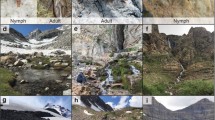Abstract
The state of Florida has a complex biogeography which is the product of past sea level changes and associated ocean currents creating numerous inland sand ridge systems which are home to a unique biota adapted to the seasonally dry conditions found on these sandy uplands. Among these xeric-adapted taxa is a suite of wolf spider species in the genus Geolycosa. Geolycosa wolf spiders are habitat specialists and poor dispersers, and many taxa have ranges restricted to specific ridge systems. We found that the six Geolycosa species typical of Florida's scrubs and sandhills (G. escambiensis Wallace, G. ornatipes (Bryant), G. micanopy Wallace, G. patellonigra Wallace, G. hubbelli Wallace and G. xera McCrone) have current distributions that correlate with the historical biogeography of the state. There are species typical of the Lake Wales Ridge and associated ridges (G. xera and G. hubbelli), species found on the more coastal ridges (G. patellonigra and G. micanopy) and species whose ranges are divided by the Apalachicola River drainage (G. escambiensis and G. ornatipes). We also found that Geolycosa wolf spiders tend to occur in species pairs which use different microhabitats: those which burrow in areas covered in leaf litter, and those which use only barren sites. These latter species require habitat management plans that include burns, that maintain the habitat in an open condition.
Similar content being viewed by others
References
Abrahamson, W.G., Johnson, A.F., Layne, J.N. and Peroni, P.A. (1984) Vegetation of the Archbold Biological Station: an example of the southern Lake Wales Ridge. Fla. Scient. 47, 209-50.
Corey, D. (1991) Burrow structure and placement in Geolycosa xera (Araneae: Lycosidae). Fla. Scient. 54, 125-8.
Deyrup, M.A. (1989) Arthropods endemic to Florida scrub. Fla. Scient. 52, 254-70.
Deyrup, M.A. (1996) Two new grasshoppers from relict uplands of Florida (Orthoptera: Acrididae). Trans. Am. Ent. Soc. 122, 199-211.
Dondale, C.D. and Redner, J.H. (1990) The Wolf Spiders, Nurseryweb Spiders and Lynx Spiders of Canada and Alaska. The Insects and Arachnids of Canada, Part 17. Research Branch, Agriculture Canada, Pub. 1856. Ottawa, Canada.
Edwards, R. and Edwards, E. (1989) Cape Cod's burrowing wolf spiders. Cape Cod Naturalist 18, 12-19.
Hawkes, C. and Menges, E. (1996) The relationship between open space and fire for species in a xeric Florida shrubland. Bull. Torrey Botanical Club 123, 81-92.
Hubbell, T. (1954) Relationships and distribution of the genus Mycotrupes. Misc. Pubs. Mus. Zool., Univ. Mich, No. 84. pp. 39-51.
Laessle, A. (1968) Relationship of sand pine scrub to former shore lines. Quart. Jnl of the Florida Academy of Science 30, 269-86.
Lewis, P. and Crawford, D. (1995) Pleistocene refugium endemics exhibit greater allozyme diversity than widespread congeners in the genus Polygonella (Polygonaceae). Am. J. Bot. 82, 141-9.
MacNeil, F.S. (1951) Pleistocene shore lines in Florida and Georgia. U.S. Geol. Surv. Prof. Paper, No. 221-F.
Marshall, S.D. (1994) Geolycosa escambiensis. In: Rare and Endangered Biota of Florida: Vol. IV, Invertebrates (M. Deyrup and R. Franz, eds) pp. 233-5. Gainesville: University Presses of Florida.
Marshall, S.D. (1995a) Natural history, activity patterns, and relocation rates of a burrowing wolf spider: Geolycosa xera archboldi McCrone (Araneae, Lycosidae). J. Arachnol. 23, 65-70.
Marshall, S.D. (1995b) Mechanisms of the formation of territorial aggregations of the burrowing wolf spider Geolycosa xera archboldi McCrone (Araneae, Lycosidae). J. Arachnol. 23, 145-50.
Marshall, S.D. (1996) Evidence for territorial behavior in a burrowing wolf spider. Ethology 102, 32-9.
Marshall, S.D. (1997) The ecological determinants of space use by a burrowing wolf spider in a xeric shrubland ecosystem. J. Arid Environ. 37, 379-93.
Marshall, S.D. (1999). Neighborhood effects within territorial aggregations of the burrowing wolf spider Geolycosa xera archboldi McCrone (Araneae: Lycosidae). Can. J. Zool. 77, 1006-1012.
McCrone, J.D. (1963) Taxonomic status and evolutionary history of the Geolycosa pikei complex in the Southeastern United States (Araneae, Lycosidae). Am. Mid. Nat. 70, 47-73.
Menges, E., Abrahamson, W., Givens, K., Gallo, N. and Layne, J. (1993) Twenty years of vegetation change in five long-unburned Florida plant communities. J. Veg. Sci. 4, 375-86.
Miller, G. (1989) Subsocial organization and behavior in broods of the obligate burrowing wolf spider Geolycosa turricola (Treat). Can. J. Zool. 67, 819-24.
Moler, P. and Kezer, J. (1993) Karyology and systematics of the salamander genus Pseudobranchus (Sirenidae). Copeia, 39-47.
Neill, W.T. (1957) Historical biogeography of present day Florida. Bull. Fl. State Mus., Biol. Sci. 2, 175-220.
Osentoski, M. and Lamb, T. (1995) Intraspecific phylogeography of the gopher tortoise, Gopherus polyphemus: RFLP analysis of amplified mtDNA segments. Mol. Ecol. 4, 709-18.
Pulliam, H.R. and Babbitt, B. (1997) Science and the protection of endangered species. Science 275, 499-500.
Wallace, H.K. (1942) A revision of the burrowing spiders of the genus Geolycosa (Araneae, Lycosidae). Am. Mid. Nat. 27, 1-62.
Webb, S.D. (1990) Historical biogeography. In: Ecosystems of Florida (R.L. Myers and J.J. Ewel, eds) pp. 70-100. Orlando: The University of Central Florida Press.
Author information
Authors and Affiliations
Rights and permissions
About this article
Cite this article
Marshall, S., Hoeh, W. & Deyrup, M. Biogeography and conservation biology of Florida's Geolycosa wolf spiders: threatened spiders in endangered ecosystems. Journal of Insect Conservation 4, 11–21 (2000). https://doi.org/10.1023/A:1009688519138
Issue Date:
DOI: https://doi.org/10.1023/A:1009688519138




